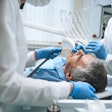Valerie Powell, Ph.D., is on a mission.
The 70-year-old professor of computer science at Robert Morris University in Pittsburgh says the creation of an electronic health record (EHR) that combines both medical and dental data cannot wait until 2015.
That is when the U.S. National Health Information Infrastructure (NHII) is slated to be up and running, and doctors and dentists are expected to be in compliance with federal mandates regarding the adoption of EHRs.
“Our nation needs excellent chronic care, and to make this happen means ensuring that the dentists and physicians can communicate.”
— Valerie Powell, Ph.D.
A new study shows that dentists aren't moving fast enough to meet these requirements, and that usability of existing software products is the problem. Others argue that patient privacy and implementation costs are the real issues.
Either way, Powell -- who recently hosted a teleconference with dental and medical experts that resulted in a 40-page report on EHRs that is being submitted to Tom Daschle, the nominee for secretary of the U.S. Department of Health and Human Services -- is adamant that EHRs must be adopted ASAP. There are too many chronically ill people who need dentists and physicians to start communicating now, she says.
Foremost among these patients are diabetics, a population she became very familiar with in her second career as a radiology technician. In fact, the correlation between periodontitis and diabetes is a prime example of why physicians and dentists should be sharing information sooner rather than later, argues Powell, who serves on a Pennsylvania task force that deals with the problem.
"Our nation needs excellent chronic care, and to make this happen means ensuring that the dentists and physicians can communicate," she said. "People are dying. This is urgent now."
Practitioners balk
The merits of transitioning to a paperless medical and dental office have been touted for years: increased efficiency, better care, fewer mistakes, the ability to track a condition over time or access patient information anytime, anyplace, anywhere -- the list goes on and on.
And once the NHII is in place, its designers and developers envision "regional collaborations among healthcare entities, including dentists and other healthcare practitioners, so that a patient's information can be securely stored in the local community and made electronically accessible to all healthcare providers involved in treatment of a particular patient," according to the ADA Web site.
And yet, adoption among the medical and dental communities remains low. According to a study published last month in the Journal of the American Dental Association, "In both medicine and dentistry, practitioners in solo and small-group practices have been slow to adopt CPRs (computer-based patient records). ... In dentistry, 25 percent of all general practitioners in the United States used a computer in at least one of their operatories in 2005. ... However, as of 2005, only 1.8 percent of general dental offices maintained patient records almost completely on the computer, suggesting a low adoption rate of CPRs" (JADA, December 2008, Vol. 139:12, pp. 1632-1642).
Building from previous research that suggested usability might be the issue, researchers from the University of Pittsburgh Center for Dental Informatics and New York University College of Dentistry evaluated four commercial practice management software products -- Dentrix (Henry Schein), EagleSoft (Patterson Dental), Kodak SoftDent (Carestream Health), and Kodak PracticeWorks (Carestream Health/PracticeWorks) -- to assess the ease of usability of their charting interfaces.
Working with four full-time dental faculty members, eight practicing dentists, and eight senior dental students from the university who all had computer (Windows) experience but no dental CPR familiarity, the researchers concluded that all four systems have "significant usability problems for novice users, resulting in a steep learning curve and potentially reduced system adoption."
The authors noted that "several lessons for the future design and redesign of dental CPR systems emerged from our analysis of design features responsible for usability problems." For example, task flow and models in the CPR systems "should be aligned more closely with common practice," and data entry and retrieval controls "should correspond with the tasks to be completed, while unrelated or extraneous controls should not be shown."
Two of the vendors whose products were part of the study -- Patterson and PracticeWorks, a subsidiary of Carestream Health -- took some exception to the findings (Henry Schein did not respond to our requests for comment). In particular, they noted that the study was done in a laboratory setting without the subjects receiving any training.
"Because our software is so robust and has to be able to accommodate the functionality of many different offices, part of our training is not just teaching users how to use the software but seeing how each office functions and setting up the software so it flows naturally for them," said Jana Berghoff, corporate technology manager at Patterson. "If you just sit down [at the computer] without a trainer, it might not feel so intuitive."
PracticeWorks U.S. CEO Patrik Eriksson agreed. "The research did not have a training component to it, so there is a difference between what was researched and what a normal customer would experience," he said, adding that the company is taking the study's findings "to heart" and that it is time to "redesign the way that software works."
In addition, the company has released two versions of PracticeWorks since the study was conducted, noted Larry Greenspan, vice president of development at PracticeWorks.
"There have been 572 enhancements to our products this year, and these are all customer-requested enhancements," he said.
One vendor that was not part of the study believes the JADA study is not so much about the software but about the users of clinical records.
"I think the most important aspect of this article is that there is a need to standardize clinical data so it can be exchanged between all offices," said Mark Hollis, president of MacPractice, the only Mac-based practice management and EHR system on the market. "Our highest priorities in product design have to do with flexibility and customizability. This allows us to recreate the model and the forms an office is accustomed to. You have to get people to buy into wanting to change, so the more your electronic system reflects what they are familiar with in a paper system, the easier the transition."
Tom Cockerell, D.D.S., agrees.
"In my opinion, the conclusions the researchers draw are not really that important in the clinical setting. From a pure research point of view, where data accumulates beginning with the ground floor, it is good to have this information," said Dr. Cockerell, a practicing dentist in Fort Worth, TX, and founder of an Internet-based patient record system company called Dental Symphony. "But it doesn't provide much value in answering the overriding question: why, after 30 years of computer records being available, do only 2% of dentists use them to manage patient care? Their conclusion is that usability is keeping dentists from adopting electronic records to manage patients, but there are bigger overriding issues."
In part II of this series, we look at how patient privacy, legacy software, and a lack of return on investment are also impeding adoption of electronic health records.



















